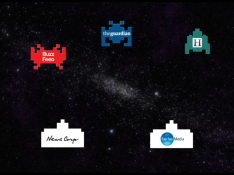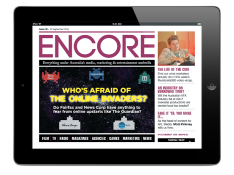Who’s afraid of the online invaders?
 With new entrants into the online news space such as The Guardian and The Conversation, do established players like Fairfax and News Corp have anything to fear? In a feature that first appeared in Encore, Nic Christensen investigates.
With new entrants into the online news space such as The Guardian and The Conversation, do established players like Fairfax and News Corp have anything to fear? In a feature that first appeared in Encore, Nic Christensen investigates.
It wasn’t long after The Guardian newspaper confirmed it would launch an Australian edition in January this year that the local media began speculating about the threat to established players.
It was Fairfax in The Guardian’s cross hairs, reported The Australian, just days after Guardian UK editor Alan Rusbridger confirmed the expansion. The broadsheet ran with the headline: “High-end, left-leaning websites on notice.” In the months that followed both News and Fairfax took swipes at the UK newspaper. Jack Matthews, then boss of Fairfax metro told Encore’s sister publication Mumbrella: “If there’s five or six journalists against our 700, I like our chances.”
Senior News Corp editorial executive Campbell Reid criticised the logic of the operation comparing it to reading the “Australian version of Playboy”, when you could just get the original.
It was left to ABC’s managing director Mark Scott to strike a more conciliatory and moderate tone at the launch of the Australian arm of The Guardian six months later.
“In the digital world there is competition but there is competition of a different kind. There is competition for advertisers but we also compete to be the homepage of an audience. But we all understand that that audience will graze widely in an online world,” Scott told the gathering of largely media industry insiders.
“There is not an exclusive hold over audiences anymore and so The Guardian’s arrival in Australia really adds something distinctive to the mix.”
“More competition will keep everyone sharp and alert. It’s good news for the industry and for the audience.”
The Guardian is perhaps the most high profile digital startup to launch locally in recent years, yet it is far from alone in the space.
The Global Mail, The Conversation and a reinvigorated New Matilda are some of the independent Australian news websites searching for an audience. But they are also being joined by a raft of major overseas operators including The Guardian, Business Insider and Politifact, all of which launched this year. At the same time Buzzfeed and the Huffington Post have revealed their intentions to set up shop Down Under.
Jane Huxley, former head of digital for Fairfax Media, says: “There is a lot going on in the Australian space. These digital pure-plays are interesting. The Guardian didn’t come in here to print a newspaper. They came in here with a digital only operation. When you look at that, comparatively to some of the traditional models, an operation with 12 or 15 people is going to look like a low cost model.” Huxley certainly understands the potential for digital upstarts. She is now the head of Pandora Radio, a music streaming service and online challenger to traditional commercial radio models.
Huxley says the people behind the likes of Politifact, Buzzfeed and The Guardian see opportunity in the Australian market. “When you see an opportunity with an audience of size, a smart publisher with a lean start up cost will see it is easy to make a low risk, low entry move that secures a foothold in the market,” she says.
While The Guardian did not respond to requests for comment regarding the strategy behind its entry into the local market, Peter Fray, editor-in-chief of Politifact says the fact checking organisation he runs can easily relate to that statement. Fray imported the political fact-checking model developed by the Tampa Bay Times in the US and in the run up to the recent Australian Federal election secured media partnerships with the Seven Network and Fairfax Media. He hopes to maintain these relationships post-election. “In Seven and Fairfax’s case they have seen the value in what we do,” he says. “There was a lot of discussion about whether we were there to cut the journo’s lunch and we certainly haven’t done that. What we are is another form of engagement.”
The competition question is an important one. Margaret Simons, journalism academic, says the so-called “legacy media” is slowly losing its ability to dominate the media cycle.
“I suspect this will be one of the last Federal elections where the legacy media has an unrivaled reach,” says Simons. “Today, anyone who wants to be well informed can find a great deal of good content available but they do have to go looking for it. As the digital natives grow older, and as social media develops and converges, those sorts of media will be more readily available. That will reduce the propagandising power of mainstream media. That is all happening really quickly.”
According to data from Nielsen, competition among the major news websites has recently intensified with a reordering of the top sites in Australia. Ninemsn and the Sydney Morning Herald recently conceded the top spots to News Corp.
At present the top 10 online news sites remain traditional media players.
Luke McIlveen, editor of News.com.au, the top ranking site which, according to Nielsen had 2.9m readers in July, says: “The competition is fierce. In the last year we have seen a more energetic race to be number one and of course the internet is an infinite space. It’s no surprise to me that new players are trying to collar the Australian audience – that’s the way it should be.”
However, he believes that other types of online ‘invaders’ will be targeting different segments of the market. McIlveen says: ”You don’t take any competitor lightly but I’m not sure I see The Guardian as ‘new media’ – it’s one of the oldest newspaper brands in the world. That said, they are clearly having some success although I’d argue that is likely to be at the expense of a player like the SMH.”
For McIlveen the future threat is more likely to come from the likes of Buzzfeed, a US website known for its viral content. “Buzzfeed do a wonderful job. They have a formula that resonates with younger readers. They would absolutely be a competitor to us.”
Pandora’s Huxley says the impact of the new entrants is beginning to play out. “We are seeing that right now,” says Huxley. “If they want to compete, they need to be bold. You can’t compete by being conservative in a disrupted market.”
Like many, Huxley believes it will be interesting to see how Fairfax and News Corp’s metered and cookies-based paywalls work over the long term but says all publishers need to find ways to leverage their assets.
“They need something that is going to trade off the value of the brand and keep customers loyal,” says Huxley. “That is kind of the antithesis of putting up a paywall. There is no panacea except to focus on the core competency of what an organisation is. Cut away the stuff that is a distraction and be the best at one thing.”
One organisation which in recent times has come to prominence particularly in the area of specialist academic knowledge is The Conversation. Under Andrew Jaspan, former editor-in-chief of The Age, the site has grown to more than a million unique browsers a month.
“We’re just over two years old. We have just had our first election and we have thrown a lot at it,” Jaspan tells Encore. “We are quite different to the other online players. No one has the same model we do.”
The Conversation draws revenue from a variety of sources, mainly universities as the site brings together a wide commentary and analysis from the nation’s academics.
Jaspan says: “We have 27 universities who fund The Conversation, plus CSIRO funding. Then we have additional revenue in the form of corporate support, donations and classified jobs revenue.”
To the likes of Huxley this multi-pronged revenue model is likely to be the future for many digital publishers. She says: “Revenue for most digital operations is going to have to come outside of core business. My view is that these start ups will need to look at a bold investment strategy which diversifies the base.”
The Conversation also employs the unusual approach of allowing other publishers to use content from its contributors, who now include the likes of political columnist Michelle Grattan. The content can appear in other publications free of charge. “I don’t think we pose a threat to traditional media – quite the reverse actually. Everything we publish is free for everyone to use,” says Jaspan. “That means the likes of APN, The Guardian, Business Spectator, Western Australian newspapers, The NZ Herald and a variety of online websites regularly use our content.”
Jaspan argues grazing or consumption of aggregated content is the future. “The online world is quite different to the old media world which says, ‘if I take something from you, it means less for someone else’,” he says.
Academic Simons agrees but says that the competitive market will see the various enterprises forced to discover different models to survive.
“We will see a variety of business models and the old business model will still exist as well,” says Simons. “Advertising is a very old way of earning money and I don’t think it is going to disappear but there will have to be other models as well.”
The question then becomes whether the Australian market is big enough for both the traditional media players and the plethora of new online news websites. Politifact’s Fray is confident there is enough space for both.
“There is enough room but they have to be very defined as to what their market is and their audience is, particularly with the newer online startups,” says Fray. “You see that in The Guardian quite clearly and also in the evolving nature of news website Crikey. The Conversation also has it’s own thing with the marriage of journalism and academia.”
“Is the revolution happening overnight? I don’t think it is but rather I think will be a slow burn for audiences.”
 This feature is from the weekly edition of Encore available for iPad and Android tablets. Visit encore.com.au for a preview of the app or click below to download.
This feature is from the weekly edition of Encore available for iPad and Android tablets. Visit encore.com.au for a preview of the app or click below to download.




There wouldn’t be an “opportunity” for the big overseas media players to enter the marketplace if the Australian ones were doing their job and meeting the demands of the Australian audience in the first place.
Personally as an on-line news audience (their target market) I welcome the competition. Hopefully I start reading more newsworthy content which the Conversation frequently provides me with.
User ID not verified.
The Conversation as the future? Really? Begging for money from public institutions while calling yourself “independent”? And giving the content away is certainly easier if you don’t give a cent to the writers. What a joke.
User ID not verified.